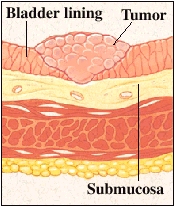Once cancer has been diagnosed, the next step is to choose the best way to treat it. To help do this, your doctor checks how deep the cancer has grown and whether it has spread (the cancer stage).
Stage: How Much the Cancer Has Grown and Spread
As cancer cells multiply, the tumor grows. Bladder cancer begins in the lining of the bladder, and often doesn’t grow beyond that layer. As the tumor gets larger, it may invade (grow into) deeper layers of the bladder. It may also invade nearby organs, such as the prostate in men or the uterus in women. Cells can break off from the main tumor and enter the bloodstream or lymph nodes. Blood or lymph then carries the cells to other areas of the body, such as the bones, liver, or lungs, where a new growth may form. This process is called metastasis. The stage of cancer is based on where the cancer is and how much it has grown and spread. The stage is found by looking inside the bladder during cystoscopy and using tests that show images of the bladder, the areas around it, and parts of the body that the cancer may spread to. The staging system described below is a simplified one. Your doctor will most likely use a more detailed system.



